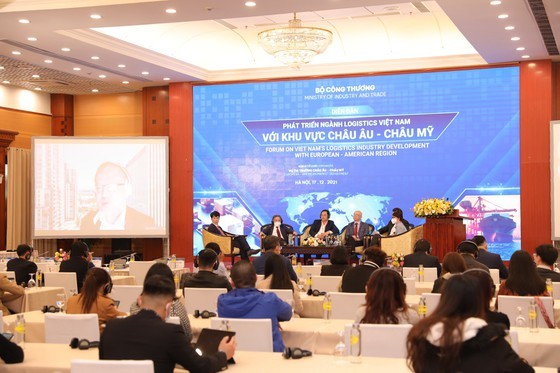 The scene of the forum on Vietnam's logistics industry development with European and American region organized by the Ministry of Industry and Trade (MoIT) on the morning of December 17. (Photo: SGGP)
The scene of the forum on Vietnam's logistics industry development with European and American region organized by the Ministry of Industry and Trade (MoIT) on the morning of December 17. (Photo: SGGP)
This information was given at the forum on Vietnam's logistics industry development with European and American region organized by the Ministry of Industry and Trade (MoIT) on the morning of December 17.
Logistics costs soar
With 20 years of experience in logistics services, directly exporting stone products to the US and European markets, and supplying seafood to the Vietnamese market, Ms. Jolie Nguyen, General Director of Global Maritime Services Company shared that the past two years had been a really difficult period not only for logistics businesses but also for import and export ones when transportation costs had skyrocketed during the Covid-19 pandemic.
Freight rates in 2021 have risen 3-4 times compared to 2020 and 8-9 times higher than in 2019 due to a shortage of empty containers and congestion at seaports. In the past two days, at the US Port of Long Beach, there have been still 101 ships from North America to Mexico lying in wait. This situation cannot be resolved overnight but might last until 2022.
In addition, in the past, freight rates were usually fixed for 1-2 months, but now they are changed every 15 days. Therefore, logistics enterprises have the psychology to export goods at all costs for fear that the freight rates may increase. Due to the lack of containers and ships, shipping lines do not prioritize heavy goods, such as stones, leading to a break in the global supply chain. Earlier, a container only needed 4-5 weeks to arrive at the main port, but now it takes up to 80 days.
Providing more information, Mr. Nguyen Hoai Nam, Deputy General Secretary of the Vietnam Association of Seafood Exporters and Producers, said that logistics activities in the past two years had brought pains to import and export activities of enterprises in general and the seafood industry in particular. Currently, the European and American markets account for 38% of Vietnam's seafood export market. However, the freight to the US has increased from US$3,500 per container to $13,000-$17,000 per container, depending on the destination to the East or West coast. As for goods transported to Europe, the freight has climbed from $2,000 per container to $12,000-$14,000 per container, depending on the destination to the main port or the auxiliary one. For goods to the Middle East, the shipping fee has surged from $1,500 to $10,000 per container. Moreover, enterprises have to bear many other additional costs, such as port congestion fees, cleaning fees, clean fuel fees, and container balancing.
Regarding this issue, Mr. Do Thang Hai, Deputy Minister of Industry and Trade, said that along with the positive results, export growth has revealed many inadequacies in the logistics industry. Typically, the transport and seaport infrastructures are seriously degraded; old warehouses fail to meet the standards of import-export partners; the administration has not yet applied complete technology; not to mention that the traffic congestion at cities and provinces due to pandemic control has caused the delivery time to be prolonged. These issues have created great challenges for import and export enterprises.
Diversifying routes
Roger Wu, Marketing Manager at Port of Long Beach, said that in the context of the Covid-19 pandemic, consumption demand climbed, leading to a sharp increase in the volume of imported goods. During the peak of the pandemic, the port system had to handle millions of containers but had to comply with safety guidelines of the US Government, so congestion at the port was unavoidable. However, this situation would improve in the near future. Export products from other countries must standardize standards at the request of the importing country to avoid being controlled and reduce the time for customs clearance of goods.
Experts said that Vietnam needs to improve infrastructure at seaports, digitize, and automate logistics activities. Simultaneously, the country should develop a one-stop mechanism for commercial and business transactions, and at the same time, apply a paperless process at border-gate customs. By synchronizing these solutions, it will help enterprises proactively plan their export and shorten the time.
As for the shipping stage, Mr. Le Quang Trung, Deputy General Director of Vietnam National Shipping Lines Corporation (Vinalines), emphasized further that Vietnam has 45 national seaports, of which Vinalines manages 16 seaports. In the long term, it is necessary to implement synchronous solutions to develop logistics and support for exports. Specifically, Vietnam should build a complete marine ecosystem domestically and abroad, a logistics center capable of receiving goods in the context that production flourishes as currently, upgrade the connection of maritime infrastructure with economic centers and industrial parks, and develop an open port model, which allows the common use of related infrastructure resources between adjacent and neighboring ports in the country, domestic with foreign ports to increase the internal capacity of ports but reduce investment costs.
More importantly, it is necessary to establish a Vietnamese-branded shipping route instead of depending on some major shipping lines globally. In fact, on November 25, Vinalines directly connected the Vietnam - Malaysia - India shipping route. This approach has helped reduce the pressure of transportation of goods and stabilize the price of transport supply, supporting domestic exporters.
Currently, the service route directly connects Ho Chi Minh City and Hai Phong ports to India's largest gateways with a competitive transport time, which reduces ten days shorter than the previous transit route through Port Kelang. This fact has also opened up a new method in the organization of logistics chains. Businesses can link to actively charter ships to transport their orders without completely depending on the booking schedule from MLO shipping lines.
Logistics costs soar
With 20 years of experience in logistics services, directly exporting stone products to the US and European markets, and supplying seafood to the Vietnamese market, Ms. Jolie Nguyen, General Director of Global Maritime Services Company shared that the past two years had been a really difficult period not only for logistics businesses but also for import and export ones when transportation costs had skyrocketed during the Covid-19 pandemic.
Freight rates in 2021 have risen 3-4 times compared to 2020 and 8-9 times higher than in 2019 due to a shortage of empty containers and congestion at seaports. In the past two days, at the US Port of Long Beach, there have been still 101 ships from North America to Mexico lying in wait. This situation cannot be resolved overnight but might last until 2022.
In addition, in the past, freight rates were usually fixed for 1-2 months, but now they are changed every 15 days. Therefore, logistics enterprises have the psychology to export goods at all costs for fear that the freight rates may increase. Due to the lack of containers and ships, shipping lines do not prioritize heavy goods, such as stones, leading to a break in the global supply chain. Earlier, a container only needed 4-5 weeks to arrive at the main port, but now it takes up to 80 days.
Providing more information, Mr. Nguyen Hoai Nam, Deputy General Secretary of the Vietnam Association of Seafood Exporters and Producers, said that logistics activities in the past two years had brought pains to import and export activities of enterprises in general and the seafood industry in particular. Currently, the European and American markets account for 38% of Vietnam's seafood export market. However, the freight to the US has increased from US$3,500 per container to $13,000-$17,000 per container, depending on the destination to the East or West coast. As for goods transported to Europe, the freight has climbed from $2,000 per container to $12,000-$14,000 per container, depending on the destination to the main port or the auxiliary one. For goods to the Middle East, the shipping fee has surged from $1,500 to $10,000 per container. Moreover, enterprises have to bear many other additional costs, such as port congestion fees, cleaning fees, clean fuel fees, and container balancing.
Regarding this issue, Mr. Do Thang Hai, Deputy Minister of Industry and Trade, said that along with the positive results, export growth has revealed many inadequacies in the logistics industry. Typically, the transport and seaport infrastructures are seriously degraded; old warehouses fail to meet the standards of import-export partners; the administration has not yet applied complete technology; not to mention that the traffic congestion at cities and provinces due to pandemic control has caused the delivery time to be prolonged. These issues have created great challenges for import and export enterprises.
Diversifying routes
Roger Wu, Marketing Manager at Port of Long Beach, said that in the context of the Covid-19 pandemic, consumption demand climbed, leading to a sharp increase in the volume of imported goods. During the peak of the pandemic, the port system had to handle millions of containers but had to comply with safety guidelines of the US Government, so congestion at the port was unavoidable. However, this situation would improve in the near future. Export products from other countries must standardize standards at the request of the importing country to avoid being controlled and reduce the time for customs clearance of goods.
Experts said that Vietnam needs to improve infrastructure at seaports, digitize, and automate logistics activities. Simultaneously, the country should develop a one-stop mechanism for commercial and business transactions, and at the same time, apply a paperless process at border-gate customs. By synchronizing these solutions, it will help enterprises proactively plan their export and shorten the time.
As for the shipping stage, Mr. Le Quang Trung, Deputy General Director of Vietnam National Shipping Lines Corporation (Vinalines), emphasized further that Vietnam has 45 national seaports, of which Vinalines manages 16 seaports. In the long term, it is necessary to implement synchronous solutions to develop logistics and support for exports. Specifically, Vietnam should build a complete marine ecosystem domestically and abroad, a logistics center capable of receiving goods in the context that production flourishes as currently, upgrade the connection of maritime infrastructure with economic centers and industrial parks, and develop an open port model, which allows the common use of related infrastructure resources between adjacent and neighboring ports in the country, domestic with foreign ports to increase the internal capacity of ports but reduce investment costs.
More importantly, it is necessary to establish a Vietnamese-branded shipping route instead of depending on some major shipping lines globally. In fact, on November 25, Vinalines directly connected the Vietnam - Malaysia - India shipping route. This approach has helped reduce the pressure of transportation of goods and stabilize the price of transport supply, supporting domestic exporters.
Currently, the service route directly connects Ho Chi Minh City and Hai Phong ports to India's largest gateways with a competitive transport time, which reduces ten days shorter than the previous transit route through Port Kelang. This fact has also opened up a new method in the organization of logistics chains. Businesses can link to actively charter ships to transport their orders without completely depending on the booking schedule from MLO shipping lines.
Five tasks for the sustainable logistics development
Earlier, Minister of Industry and Trade Nguyen Hong Dien pointed out five main tasks for Vietnam's logistics industry to develop quickly and sustainably at the Vietnam Logistics Forum 2021, taking place in Hanoi on the afternoon of December 14.
They include promoting digital transformation and increasing the application of achievements of the fourth industrial revolution in logistics to accelerate maximum automation of operational processes, reduce risks, and improve efficiency, and significantly improve the operational efficiency of the supply chain in the context of limited human resources and volatile markets; implementing solutions to synchronously develop the system of transport, seaport, and warehouse infrastructure; connecting modes of transport; promoting the establishment of free trade zones, creating favorable conditions for localities to develop into large logistics service centers; focusing on developing human resources for logistics; synchronously deploying solutions to reduce costs and improve logistics efficiency; continuing to promote the reform and simplification of administrative procedures related to logistics activities in the direction of minimizing inspection procedures at the import stage, enhancing post-inspection and transparency in customs procedures, facilitating favorable conditions for Vietnam's logistics industry to develop sustainably.
Earlier, Minister of Industry and Trade Nguyen Hong Dien pointed out five main tasks for Vietnam's logistics industry to develop quickly and sustainably at the Vietnam Logistics Forum 2021, taking place in Hanoi on the afternoon of December 14.
They include promoting digital transformation and increasing the application of achievements of the fourth industrial revolution in logistics to accelerate maximum automation of operational processes, reduce risks, and improve efficiency, and significantly improve the operational efficiency of the supply chain in the context of limited human resources and volatile markets; implementing solutions to synchronously develop the system of transport, seaport, and warehouse infrastructure; connecting modes of transport; promoting the establishment of free trade zones, creating favorable conditions for localities to develop into large logistics service centers; focusing on developing human resources for logistics; synchronously deploying solutions to reduce costs and improve logistics efficiency; continuing to promote the reform and simplification of administrative procedures related to logistics activities in the direction of minimizing inspection procedures at the import stage, enhancing post-inspection and transparency in customs procedures, facilitating favorable conditions for Vietnam's logistics industry to develop sustainably.
























